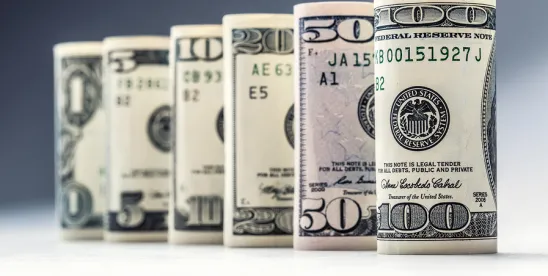On March 27, 2020, the Coronavirus Aid, Relief, and Economic Security (CARES) Act was enacted, an economic relief package in response to the COVID-19 pandemic. The CARES Act provides economic support at the federal level to the business sector, employees, individuals and families, and specific industries that have been impacted, including air transportation, healthcare, and education.
Summarized below are key aspects of the Paycheck Protection Program, a $349 billion SBA-administered loan and loan forgiveness program described in Division A, Title I – Keeping American Workers Paid and Employed Act of the CARES Act.
General
The CARES Act expands the eligibility criteria for borrowers to qualify for loans that are available through the U.S. Small Business Administration (SBA) by adding the Paycheck Protection Program to the SBA’s gamut of loan programs. The Paycheck Protection Program provides federally-guaranteed loans up to a maximum amount of $10 million to eligible businesses, which can be partially forgivable (as elaborated below), to encourage businesses to retain employees through the COVID-19 crisis by assisting in the payment of certain operational costs. To accommodate for this SBA expansion, the CARES Act has authorized commitments to the SBA 7(a) loan program, as modified by the CARES Act, in the amount of $349 billion. The Paycheck Protection Program covers the period beginning February 15, 2020 and ending on June 30, 2020 (the Covered Period).
A. Increased Eligibility for Certain Small Businesses and Organizations
In addition to a business qualifying as a “small business concern” under the Small Business Act, any business concern, nonprofit organization, veterans organization, or tribal businesses (each, a Covered Entity) is eligible to receive a loan (a Paycheck Protection Loan) during the Covered Period if the Covered Entity employs not more than the greater of (i) 500 employees (includes individuals employed on a full-time, part-time or other basis) or (ii) if applicable, the size standard in number of employees established by the SBA for the industry in which Covered Entity operates.
There are special exceptions to standard SBA regulations that relax eligibility restrictions for certain Covered Entities during the Covered Period. For example, a Covered Entity in the hospitality and dining industry designated as such under Sector 72 of the North American Industry Classification System (NAICS) (https://www.naics.com/six-digit-naics/?code=72) that employs fewer than 500 employees per physical location is eligible to receive a loan. In addition, federal regulations that reduce eligibility by testing size based on affiliations with related parties will be waived in limited circumstances.
B. Authorized Use of Proceeds
The proceeds of a Paycheck Protection Loan may be used to pay for only the following items (in each case, subject to certain specified exclusions): (i) payroll costs, (ii) costs related to group health care benefits during periods of paid sick, medical or family leave, and insurance premiums, (iii) employee salaries, commissions, or similar compensations, (iv) mortgage interest payments (but not any prepayment of or payment of principal on a mortgage obligation), (v) rent, (vi) utilities and (vii) interest on any other debt obligations that were incurred before the Covered Period.
C. Maximum Loan Amount, Interest Rate and Maturity for Loans with Remaining Balances
During the Covered Period, the maximum loan amount permitted for an eligible Covered Entity is the lesser of $10,000,000 and an amount calculated based on a payroll formula that essentially equals 2.5x the average total monthly payroll cost incurred in the one-year period before the loan is made.
The interest rates for loans borrowed by a Covered Entity under the program may not exceed four percent (4%).
Any Paycheck Protection Loan that has a remaining principal balance after any applicable loan forgiveness (as covered in detail below) must have a maturity date no later than 10 years from the date on which the borrower applied for loan forgiveness.
D. Payment Deferral
The SBA will direct lenders to defer all payments (principal, interest and fees) otherwise due under a Paycheck Protection Loan for a minimum of 6 months and a maximum of 12 months.
E. Collateral or Other Credit Support
A borrower will not be required to pledge any collateral or provide personal guarantees to secure or support a Paycheck Protection Loan.
F. Loan Forgiveness (and Potential Reduction in the Forgiveness Amount)
During the 8-week period beginning on the date a Paycheck Protection Loan is funded (the Forgiveness Period), a borrower will be eligible for forgiveness and cancellation of indebtedness for up to the full principal amount of such loan. The amount eligible for forgiveness (the Total Eligible Forgiveness Amount) is equal to the total costs incurred and payments made during the Forgiveness Period for (1) payroll, (2) mortgage interest, (3) rent and (4) utilities.
The loan forgiveness amount available to a borrower is subject to reduction if the borrower terminates employees or reduces employee salary and wages during the Forgiveness Period. There is, however, relief from the forgiveness reduction if the borrower rehires employees or makes up for wage reductions by June 30, 2020.
G. Lender Eligibility, SBA Guaranty, Fees
Lenders who are already authorized to make loans under the SBA’s existing 7(a) loan program are automatically eligible to make Paycheck Protection Loans. The SBA and the Treasury Secretary will extend eligibility to additional qualified lenders that do not currently participate in such program. Participating lenders will be permitted to determine borrower eligibility under the Paycheck Protection Program, and will be entitled to make and approve Paycheck Protection Loans, without SBA review. Participating lenders will be directed to underwrite loans not based on borrower repayment ability, but rather whether the borrower was in operation on February 15, 2020, with one or more employees or independent contractors.
Repayment of a Paycheck Protection Loan will be 100% guaranteed by the SBA.
The SBA will not charge any fees on a Paycheck Protection Loan. Participating lenders will be entitled to charge a fee, as a percentage of the original principal balance of the Paycheck Protection Loan, not to exceed the following amounts:
-
For a loan with original principal balance of $350,000 or less, 5%;
-
For a loan with original principal balance greater than $350,000 but less than $2 million, 3%; and
-
For a loan with original principal balance of $2 million and above, 1%.
Agents that assist borrowers in preparing an application for a Paycheck Protection Loan will be entitled to a fee not to exceed the amount prescribed by the SBA for such services.
As you are aware, things are changing quickly and the aid measures and interpretations described here may change. This article represents our best understanding and interpretation based on where things currently stand as of March 27, 2020 upon the signing of the CARES Act into law by the President as of approximately 4:30 pm Eastern Time this afternoon.



 />i
/>i

